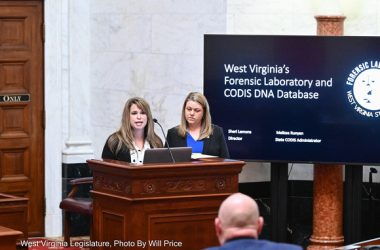
NEW MARTINSVILLE, W.Va. – Federal investigators discovered corrosion and pre-existing cracks in a railcar that leaked thousands of gallons of chlorine, which led to hundreds of evacuations in Marshall, Wetzel and Monroe counties on Aug. 27.
The National Transportation Safety Board issued a preliminary report Monday detailing the chlorine gas spill at the Axiall Natrium plant near New Martinsville.
Axiall Corp. has since been acquired by Westlake Chemical Corp. for $3.8 billion.
The NTSB was the lead investigator for spill that released 17,000 gallons of chlorine — 90 tons — Aug. 27 at the company’s Natrium chemical facility in Marshall County.
Investigators discovered corrosion and pre-existing cracks in the bottom of the railcar’s tank, which had recently undergone interior inspection and repair work. The company said hazmat crews evaluated the railcar and area affected by the leak, which authorities estimated to be approximately 26 miles.
Hundreds of people were evacuated from their homes in affected areas of Marshall and Wetzel counties. After the release, five Axiall Corp. and three contract employees were treated for exposure injuries and released, while two people were taken to an area hospital.
This was the first chlorine leak within about two months at the Natrium facility. The plant experienced another chlorine emission Oct. 8 through a scrubber. The company said this emission was identified and stopped.
No public emergency response or action was required. An environmental report about the incident was filed. No employees were injured, but one contractor reported inhalation symptoms and was treated with oxygen at the plant’s medical office, released and returned to work. The scrubber system is being analyzed to determine a cause for the emission, the company said.
According to the report, NTSB investigators completed on-site work in New Martinsville and at the Rescar Companies tank car repair facility in Dubois, Pa. The investigation will continue at NTSB headquarters in Washington, D.C.
The board reports that the shell of the railcar breached, prompting the dispatch of three investigators to the scene. Parties to the investigation are the Axiall (the railcar owner) and the Federal Railroad Administration.
The NTSB’s team has examined the railcar, gathered relevant documents and interviewed personnel involved in the loading of the railcar.
According to the NTSB report, a tanker car experienced a sudden tank shell crack around 8:26 a.m., shortly after it was filled with liquefied compressed chlorine. During the two and half hours after the crack developed, the entire 90-ton load of chlorine released from the crack to form a large vapor cloud that migrated southward and westward from the Axiall facility along the Ohio River Valley. The weather at the time of the accident was lifting fog after sunrise and a 1 mph wind flowing from the north, according to the report.
Plants in the wake of the gas cloud were affected from Proctor to Hannibal. The report said no water contamination was reported.
The West Virginia Department of Environmental Protection directed questions about the investigation to the NTSB because the incident involved a railcar.
The federal Chemical Safety Board did not investigate the spill as it did with the issues from a leak originating from a storage tank at Freedom Industries contaminated the local water supply leaving hundreds of thousands of Charleston area residents without clean drinking water in January 2014.
“Due to limited resources, the CSB is not investigating the chlorine release at Axiall,” said Hillary Cohen, communications manager for the Chemical Safety Board.
Staff Writer Casey Junkins contributed to this report.





